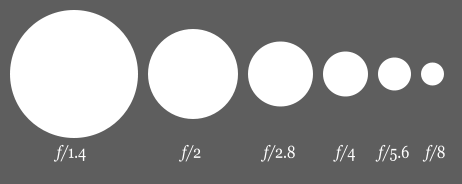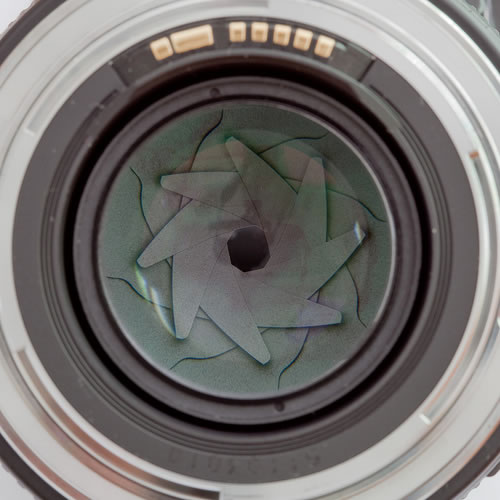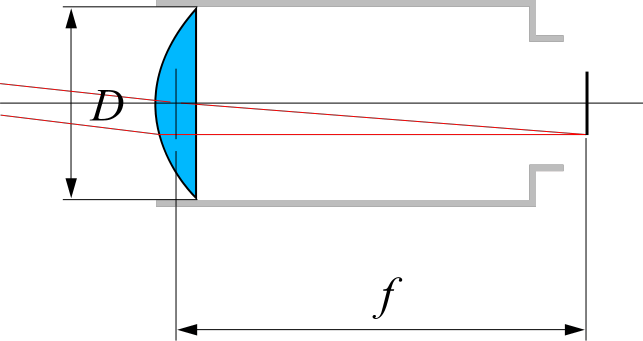Aperture literally means Opening or Hole.
A camera's aperture is a hole of varying size that influences how much light exposes an image — light passes through the opening in order to get to the image sensor (or film).
The bigger the hole (the larger the aperture), the more light reaches the sensor. The smaller the hole (the smaller the aperture), the less light reaches the sensor.Aperture is one of the three corners of the "exposure triangle" — the three settings or controls that your camera offers to allow you control over exposure. (for the other two, see Shutter Speed and ISO)
Aperture is measured, or described in "f-stops". The smaller the "f-stop", the larger the aperture. Its odd at first, but that's the system.
"Diagram of decreasing apertures, that is, increasing f-numbers, in full-stop increments; each aperture has half the light gathering area of the previous one." (WikiP)
The actual, mechanical opening is created by thin, overlapping blades that rotate inwards or outward to create a larger or smaller opening.
Here you can see the aperture mechanics a bit... blades slide, guided by grooves.
Nikon article on Aperture and Max Aperture | Aperture Intro article |
Video Tutorials
Lynda.com Foundations of Photography: Exposure Chapter 5. Aperture in Depth
Intro to Aperture @ DPChallenge | Intro to Depth of Field @ DPChallenge |
The Art of Photography (Ted Forbes): Episode 7 :: Aperture
This podcast discusses of the essence of aperture – one of the core technical concepts that controls exposure.
In the podcast, he compares aperture to turning on a faucet to fill a bathtub;
the wider the aperture, the less time it takes to “fill” an image with light;
the more open the faucet, the less time it takes to fill the tub with water.
Filling the tub is like exposing an image until it becomes fully white. To be more accurate, each and every pixel in your camera's photo-sensor is such a bathtub or a bucket — if no water (light) gets in, that pixel is black. If the bucket fills with water (light), that pixel is white.
Also, how aperture is related to depth of field is discussed (the depth of the region that is in focus).
The wider the aperture, the narrower your depth of field.
The smaller the aperture, the deeper the field of focus.
Measuring Aperture: f-stops
Aperture is measured in f-stops.
The numbers used are, at first, very peculiar.At large apertures the f-stop is a small number and each successive stop is only a slightly larger number.
As apertures get smaller, the f-stop number gets larger and the numeric gap between f-stops gets larger.The actual calculation of an f-stop = (focal length of the lens) divided by (the diameter of the aperture)
(in the diagram, above, the max diameter of the lens is "D", which is similiar to the max aperture of the lens — though the aperture will always be somewhat smaller than the lens.)
Stops
f-stops and common fractional stops:
f/1 – 1.2 – f/1.4 - 1.8 - f/2.0 – 2.2 - f/2.8 – 3.2 — 3.5 – f/4.0 – 4.5 – 5.0 — f/5.6 – 6.3 – 7.1 – f/8.0 – 9 –
f/11 – 13 – 14 – f/16 –18 – 20 – f/22 – 28 – f/32 — f/45 — f/64 — f/90 — f/128"Full Stops" are noted in bold, above.
If you think these numbers are strange... be glad we traditionally round them off to only two significant digits.
It could be worse.
Strictly speaking, f2.8 should be f2.823427...Note that each lens has its own max and min aperture (lowest f-stop and highest f-stop). These aperture variations are one of the key distinctions in lens design, lens capability and, of course, lens price.
Every full stop, the aperture doubles.
"aperture doubles" means that the lens allows twice as much light in.
So, if I change aperture from f/11 to f/8, f/8 allows twice the light in as f/11.
When the aperture is closed by a full stop (via a higher f-stop), ½ of the light is allowed in.
So if a switch from f/2.0 to f/2.8, f/2.8 lets ½ of the light in that f/2.0 lets in.When purchasing lenses, the larger the aperture (the smaller f-stop) the better – and it will cost more.
Most intro consumer zoom lenses have a maximum aperture around 4.0 or 4.5.
A professional zoom lens may have a maximum aperture of 2.8 — such a lens will cost several times more than the consumer zoom lens.
A decent 50mm prime less may have a maximum aperture of 1.8. A professional quality 50mm prime may have an aperture of 1.2 and cost a thousand dollars more than the f/1.8 lens. The size of the actual glass lenses in the f1.2 lens are much larger and are much more costly to manufacture.Where do they get those particular numbers?!
f-stop values have to do with the area inside of a circle – the circle within your open aperture that allows light into the camera. Note that every-other number is different by a factor of about 1.4. Note that 2.0 is approximately 1.4x1.4 So 1.414 is the square root of 2, which is related to the fact that when you open your aperture by a full stop, you double the amount of light allowed in.So, if you go up a full stop, you reduce exposure by half. If you go down a stop, you increase exposure by 2x.
Add a Stop or Closing Down a Stop
For the photographer, every time the f-stop increases by a factor of 1.4, the aperture is half as large — half as much light exposes the sensor.
That is, if you change the f-stop from f/1.4 to f/2.0, you've added "a stop" — you've reduced your exposure by half.
If you change from f/2.0 to f/2.8, you've added a stop.
From f/5.6 to f/8 you've added a stop.
Etc.Go Down a Stop or Open Up a Stop
And, conversly, every time the f-stop decreases by a factor of 1.4, the aperture is twice as large — twice as much light exposes the sensor.
If you change your aperture from f/16 to f/11, you've gone down a stop and double the amount of light reaching the sensor... your image will be lighter.
If you adjust your apertuure from f/5.6 to f/4, you've opened up by a full stop; twice as much light gets through.
From f/22 to f/16 is down a stop and double the aperture.Add Two Stops...
From f/5.6 to f/11 is two stops — your exposure has 1/4 as much light as before. Note that the number 11 is roughly 2x 5.
From f/11 to f/22 is up two stops — 1/4 as much light. And, obviously, 22 is 2x 11.Go up a Half Stop or a Third of a Stop...
The "in between" partial stops are even less consistent mathematically than the whole stops. Between the largest apertures, you may have approximate half steps — f/1.4 to f/1.8 is not actually a half stop, but its close enough. At smaller apertures, rough 1/3 stops are common — between f/11 and f/16, you have f/13 – f/14. The steps are not actual 1/3 steps, but, again, its close enough.
Photographers adjust freely up and down in fractional stops to improve their exposure — but they are usually not calculating aperture or percent change in illumination. They are just adding or removing exposure to lighten or darken the image — aperture adjustments become rather intuitive eventually, rather than being precisely calculated.
Its more fun that way, after all.
That’s not fully explained…I know.
The "up" and "down" jargon gets frankly confusing because f-stops increasing means aperture decreasing.
Its just one of the hazards of photography.
Sunny 16 rule
"An example of the use of f-numbers in photography is the sunny 16 rule:
an approximately correct exposure will be obtained on a sunny day by using an aperture of f/16 and the shutter speed closest to the reciprocal of the ISO speed of the film; for example, using ISO 200 film, an aperture of f/16 and a shutter speed of 1/200 second.
The f-number may then be adjusted downwards for situations with lower light." (WikiP)


